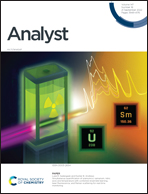Au nanoflower film-based stretchable biosensors for in situ monitoring of superoxide anion release in cell mechanotransduction†
Abstract
Cell mechanotransduction plays an important role in vascular regulation and disease development. Excessive accumulation of ROS, especially superoxide anion radicals (O2˙−), is closely related to cardiovascular diseases. Lately, NADPH oxidases, which are the major source of O2˙− production in vascular tissues, have been demonstrated to be involved in cardiovascular diseases. Therefore, in situ and real-time monitoring of superoxide anions (O2˙−) is essential for exploring the mechanisms of mechanotransduction associated with NADPH oxidase function in living cells. Here we report a rationally designed ultrasonication-assisted approach for growing Au nanoflower films on a flexible surface, which serves as the desired interface for cysteine and superoxide dismutase (SOD) anchoring to form a flexible and stretchable electrode (SOD/Cys/Au SE). The SOD/Cys/Au SE shows good stretchability, fast electron-transfer rates, and high selectivity to measure O2˙− released from cells during the stretching states. Our strategy provides a basis for developing more sophisticated stretchable biosensing tools to induce and monitor transient biochemical signals during cell mechanotransduction.

- This article is part of the themed collection: Analyst HOT Articles 2022


 Please wait while we load your content...
Please wait while we load your content...